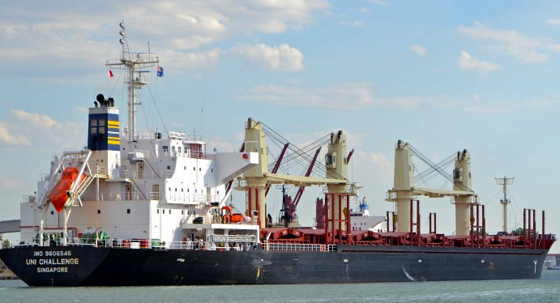Excerpts from analyst's report
NRA Capital analyst: Liu Jinshu
 Uni-Asia operates a fleet of dry-bulk carriers. Photo: Company♦ Is excess capacity in the dry bulk sector finally over? The dry spell in the dry bulk shipping sector has lasted for eight years now since the Baltic Dry Index (BDI) hit a high of 11,612 points in early June 2008. The BDI reached a low of 291 on 12 February 2016 before recovering to 640 points as of 30 June 2016. Uni-Asia operates a fleet of dry-bulk carriers. Photo: Company♦ Is excess capacity in the dry bulk sector finally over? The dry spell in the dry bulk shipping sector has lasted for eight years now since the Baltic Dry Index (BDI) hit a high of 11,612 points in early June 2008. The BDI reached a low of 291 on 12 February 2016 before recovering to 640 points as of 30 June 2016. The long decline came about as world trade volume has grown by only 14.9% from the end of 2007 while dry bulk tonnage in service has expanded by 86.6% over the same period. |
♦ Dry bulk sector may be hitting a bottom. Dry bulk capacity expansion has slowed in recent years, growing by 2.8% in 2015 and 0.5% in the first half of 2016, significantly slower than the CAGR of 7.6% over the last 8.5 years. The total number of ships that were demolished over the last 12 months now exceeds the number of bulk carriers under construction, suggesting that new supply will continue to be sluggish going forward.
Conversely, the slowdown in China trade seems to be abating with 12-month average total trade declining by 1.1% in the first five months of 2016, versus a decline of 6.9% in 2015, in RMB terms.
| UniAsia Holdings | |
| Share price: $1.16 |
Fair value: $1.615 |
♦ Rising iron ore imports by China drove gains. The growth in the dry bulk rates can be partly attributed to higher iron imports by China. The 12-month average volume of iron ore imports by China grew by 3.6% in the first five months of 2016, as opposed to growth of only 2.2% in 2015.
♦ Nascent recovery to be uneven. Given the slowing of capacity growth and the stabilization of China trade in 2016, we argue that the dry bulk sector is in in the early stages of a recovery.
| ♦ Potential re-rating over 12-24 months |
 "Uni-Asia currently trades at just 0.29x P/BV. Its peers trade from a range of 0.08x to 2.35x P/BV. We peg our valuation of Uni-Asia at 0.4x P/BV or at S$1.615. As the dry bulk sector improves, Uni-Asia may potentially be re-rated higher over the next 12 to 24 months. The key risk is whether slow economic growth will cause global trade volume to fall further. However, this risk is also mitigated by Uni-Asia’s diversified businesses and low price-to-book multiple. On balance, we classify Uni-Asia as high-average return / average risk.." "Uni-Asia currently trades at just 0.29x P/BV. Its peers trade from a range of 0.08x to 2.35x P/BV. We peg our valuation of Uni-Asia at 0.4x P/BV or at S$1.615. As the dry bulk sector improves, Uni-Asia may potentially be re-rated higher over the next 12 to 24 months. The key risk is whether slow economic growth will cause global trade volume to fall further. However, this risk is also mitigated by Uni-Asia’s diversified businesses and low price-to-book multiple. On balance, we classify Uni-Asia as high-average return / average risk.."-- Liu Jinshu (photo) |
However, the recovery will likely be slow and uneven as owners defer and accelerate ship demolitions in line with rising and falling charter rates around current levels. Nonetheless, we expect the BDI to be higher on average in 2017 as compared to 2016.
♦ Uni-Asia to benefit from improvement in dry bulk sector. The stronger charter environment suggests that Uni-Asia will likely enjoy better rates when renewing its charters.
The exact upswing will be more gradual just as Uni-Asia’s charter income has been more stable than the overall Baltic Dry Index. This is due to most of Uni-Asia’s ships being on longer term charters. As such, we expect Uni-Asia to continue to deliver modest 2Q16 results.
Full report here.





